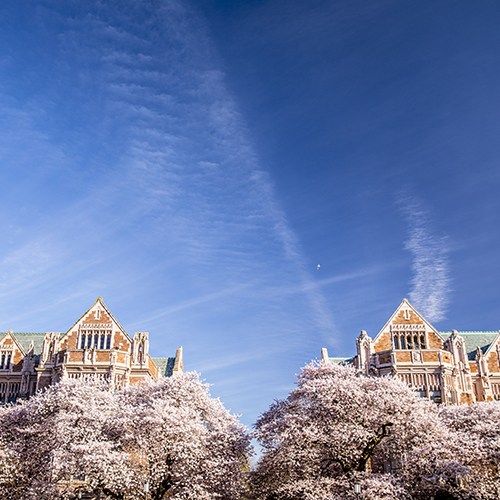Think of it as Habitat for Penguinity. Working with Parque Nacional Galápagos, Dee Boersma is behind the effort to build nests in the barren rocks of the Galápagos Islands in the hope of increasing the population of an endangered penguin species. Boersma is a UW professor of biology and Wadsworth Endowed Chair in Conservation Science.
Just as Habitat for Humanity crews help build houses for people who need shelter, Boersma's team in late September built 120 "condominiums" for penguins. The trio created holes just large enough to serve as nests along the volcanic shoreline of three islands in the Galápagos and several smaller islets.
Because of continuous warm temperatures at the equator, Galápagos penguins need shaded nests to breed. There are some mangroves, which grow in saline coastal conditions, but few other trees or shrubs along the coast to provide shade, so the birds use crevices in the rocks, lava tubes or similar spaces to find relief from the heat and protection from predators.

"Our whole goal is to increase the population of Galápagos penguins, and the way to do that is to make sure that when conditions are good, when they're not food challenged, that all of them will be able to breed," explains Boersma, who was recently honored as a "conservation hero" by the Washington chapter of The Nature Conservancy for publicizing the impact of human activity and climate change on marine ecosystems.
Galápagos penguins are the only penguin species whose range includes a bit of the Northern Hemisphere. Boersma began studying them 40 years ago while a doctoral student at Ohio State University. Since then, she has seen the population decline steadily—it is possible that fewer than 2,000 remain. The penguin species is one of two listed as endangered by the U.S. Fish and Wildlife Service.
"One of the biggest problems is the introduced species of predators," including pigs, dogs, cats and rats, Boersma says. "We went to lengths to build nests in places where there aren't introduced predators."
Habitat also has declined in the region, and new nests are needed if the population is to stabilize. While some of the same nests from 40 years ago are still in use, others have simply disappeared because of erosion and volcanic activity.
Boersma's joint project with Parque Nacional Galápagos included Burr Heneman of the Commonweal Ocean Policy Program and boat captain Godfrey Merlen and his crew from Puerto Ayora in the Galápagos.
Using local lava, they built 100 shaded nests in clusters of 5 and 10 that are relatively close together, and 20 isolated nests for penguins that prefer more isolatation. The human-built nests are virtually indistinguishable from natural holes, Boersma says. The work received financial support from the David and Lucile Packard Foundation and the UW.

The Galápagos are part of Ecuador, located in the Pacific Ocean about 600 miles from the South American mainland. Most of the islands and surrounding waters are protected as a biological marine reserve and national park, and are a United Nations World Heritage site.
Climate cycles can play havoc with Galápagos penguin reproduction. The penguins depend on cold ocean currents that rise to the surface and bring plentiful food. During El Niño years, those currents fail and most marine species have trouble finding food. During La Niña cycles, those rising cold currents increase and bring a plentiful supply of nutrients to support small fish on which the penguins feed.
Boersma hopes the new nesting sites were in place soon enough to have a positive effect as La Niña conditions take hold in the Galápagos and bring plentiful food to the penguins. She saw many penguins feeding and breeding during her recent visit.
"We found everything from eggs to small chicks to near-fledglings because the food is so good because of La Niña," she says. "The penguins are ready, if the food stays, to begin breeding. The question is will they find these new nest sites in time."
She expects to return to the Galápagos in February to evaluate the project's success.
More Stories

Demystifying Quantum
In a physics course for non-STEM majors, Professor Miguel Morales teaches quantum mechanics without the advanced mathematics most quantum courses require.

Can Machines Learn Morality?
UW researchers at the Institute for Learning & Brain Sciences and in the Allen School are exploring the potential for training AI to value altruism.

Meet Our 2025 Graduate Medalists
Meet the four graduating students selected by the College of Arts & Sciences as 2025 Graduate Medalists for their accomplishments.